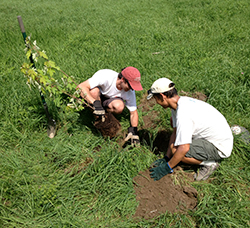Natural Landscaping to Help the Lake
 by Executive Director Chris Boget
by Executive Director Chris Boget
When you think of a typical yard, what comes to mind? Most picture a wide open area carpeted with neatly mowed turf grass. (Unless of course it is your chore to mow it every week all summer long!) Traditional lawns serve their purpose, but more and more folks in the Champlain Valley are asking: Is it time to downsize? Why not replace that wet grass area in the low point of your yard with shrubs?
If everyone reduced the force and volume of stormwater leaving their property, it would make a tremendous difference in protecting Lake Champlain. Replacing even a small patch of your lawn with native vegetation can help improve water quality, provide habitat for wildlife, add scenic beauty, and reduce mowing and maintenance needs – saving you valuable time and money.
Consider this seemingly simple question. When rain falls on your lawn, where does it go? During a light rain shower, turf grass helps absorb and slow rainwater. But during the increasingly frequent heavy storms with pelting rains, the thick and shallow root masses of traditional lawns trap water just below the surface. Most of this trapped water races across your lawn, increasing its ability to carry sediment and phosphorous into nearby waterways.
Natural landscaping mimics Mother Nature’s water retention and filtering system. Planting low-growing sedges or natural groundcovers like thyme, or starting a wildflower garden, helps slow heavy rains and soak up excess water. It is best to use perennials and shrubs native to Vermont (ask for them at your local nursery). Unlike turf grass, native plants generally have deeper root systems that help limit erosion. Natural landscapes also retain topsoil as leaves and fallen twigs, pine cones, etc. continually form a water-soaking layer of organic material above the topsoil.
Converting your lawn to more natural conditions is not an all or none proposition. Retire the grass under those low hanging tree branches that scratch you every Saturday. Plant a red-osier dogwood or red maple in that low wet spot in the corner of the yard. Or let the autumn leaves form a natural carpet in that problem spot where the grass never grows well. Vermont’s climate is perfect for growing trees and the seeds tend to last for years. You’ll be pleasantly surprised how many trees pop up on their own.
If you decide to try natural landscaping, fall is a great time to get started. Temperatures are great for planting, and many local nurseries are holding plant sales. Don’t have a lawn? You can help by retiring that steep slope in your parent’s yard next time you visit.
To learn more about natural landscaping and how to create a more lake-friendly yard, please contact us at .

